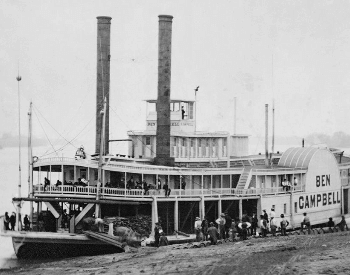
This web page contains steamboat facts for kids and is an excellent resource for anyone of any age looking to learn about steamboats. Our goal is to provide you with accurate, up to date facts about steamboats. In addition to facts about steamboats, we provide additional resources to help you with your research on steamboat technology.
The steamboat facts below will help you learn about who invented the steamboat, how a steamboat works, how safe a steamboat was and other steamboat related facts. We hope these steamboat facts are interesting and help you learn more about this revolutionary transportation invention.
If any of the below steamboat facts are inaccurate, please contact us and let us know.
19 Steamboat Facts for Kids
- A steamboat is a marine vehicle that uses steam power for propulsion.
- Steamboats were also known as steamers or steamships.
- A steamboat would propel itself using paddlewheels or propellers power by steam power.
- In 1783, the first steam-powered boat was built in France. It was called the Pyroscaphe, it was a paddle steamer and it was built by Marquis Claude de Jouffroy and some of his colleagues.
- The first commercially successful steamboat (North River Steamboat) was invented by American engineer and inventor Robert Fulton in 1807.
- Robert Fulton’s steamboat could travel between Albany, NY and New York City, NY in about 32 hours.
- Robert Fulton’s advancements in steamboat technology gave him the title “Father of Steam Navigation”.
- Steamboats use and popularity demised with the rise of the railroads.
- Steam powered trains could move people and freight faster and cheaper than steamboats.
- The railroads weren’t hindered by geographically locations (bodies of water), weather conditions and could travel any direction that rails were laid.
- There were a few different steam engine designs used in steamboats, the Newcomen steam engine, rotary motion engine, high-pressure steam engine, compound steam engine and the steam turbine.
- The Newcomen steam engine was one of the first steam engines used in steamboats, they were very heavy, took up a lot of space and generated very little power.
- The rotary motion steam engine improved the efficiency of steam engines on steamboats and allowed the mechanisms behind the paddlewheels to be simplified.
- The high-pressure steam engine was much more fuel efficient and made steamboats practical. However, high-pressure steam engines could explode if not watched and maintained.
- The compound steam engine allowed steamboats on the ocean to finally carry less fuel (coal) than freight. Prior to the compound steam engine steams on the ocean had to carry more weight in coal than in freight itself.
- The steam turbine was the most efficient steam engine used in steamboats and were used throughout the 20th century.
- Steamboat travel had its dangers, boiler explosions and fires could cause a great loss of life.
- The deadliest steamboat accident in U.S. history is also the worst maritime disaster in U.S. history.
- The Sultana was a side-wheel steamboat on the Mississippi River that exploded on April 27th, 1865. The actual death toll is unknown, but estimates put fatalities around 1,160.
Pictures of Steamboats



Additional Resources with Steamboat Facts
- A History of Steamboats – Learn about the history of steamboats on the U.S. Army website.
- Steamboats – Encyclopedia.com – Find more steamboat facts and information on the Encyclopedia.com website.
- Steamboat (Vessel) – Britannica – Discover more awesome facts about steamboats on the Britannica website.
- Steamboat – Wikipedia – Read more about steamboats and their history on the Wikipedia website.
